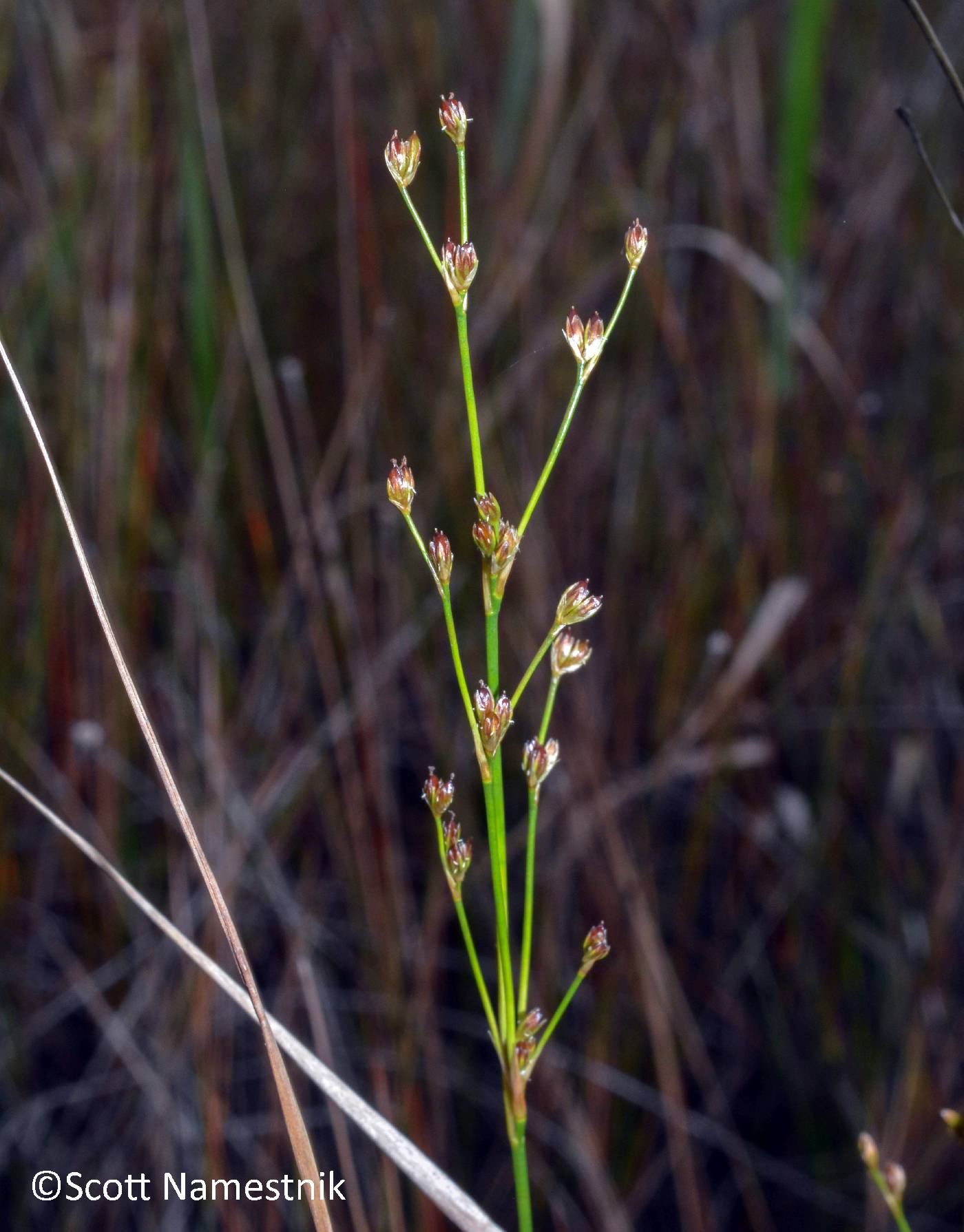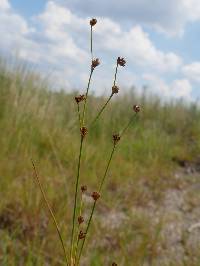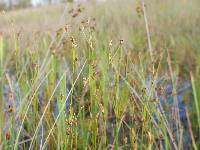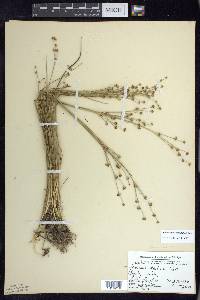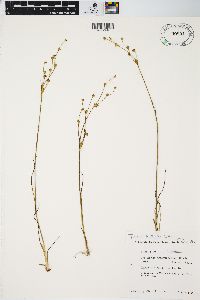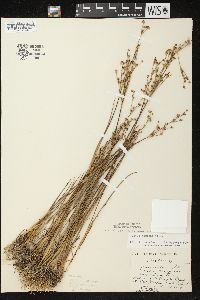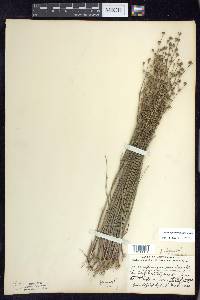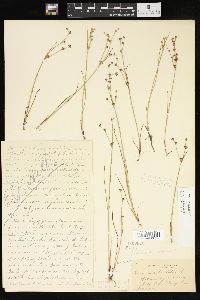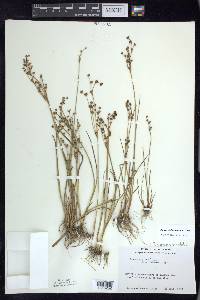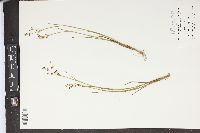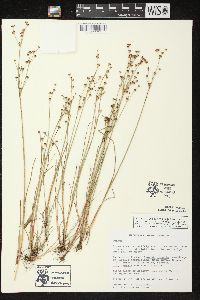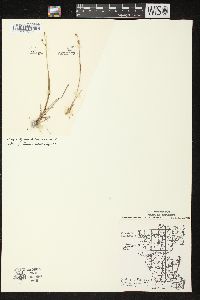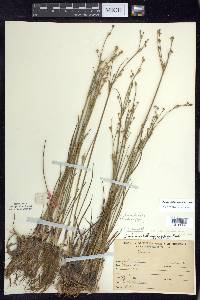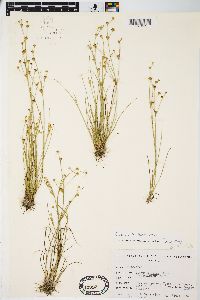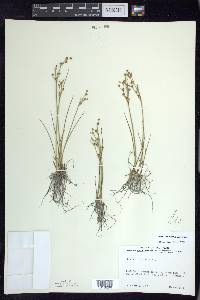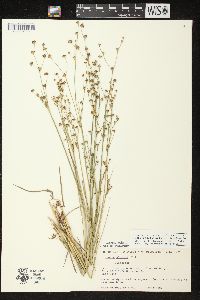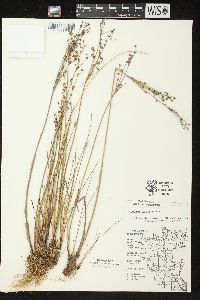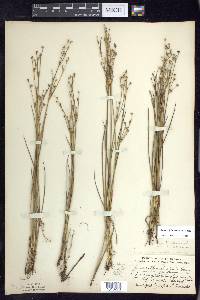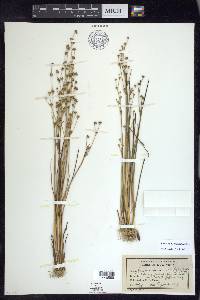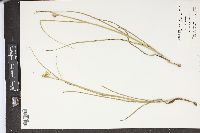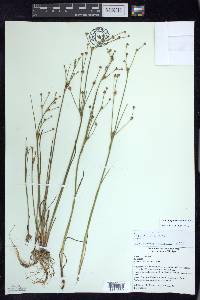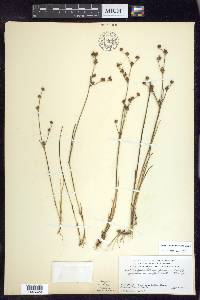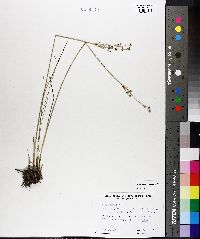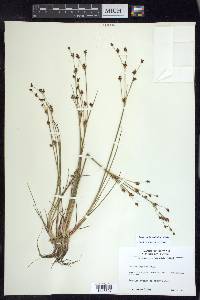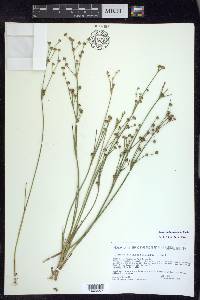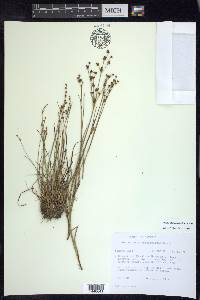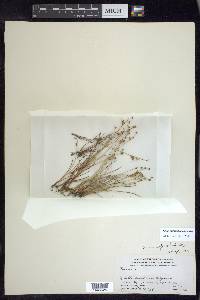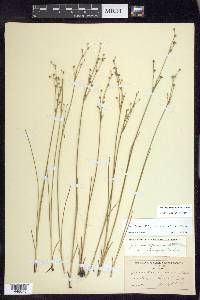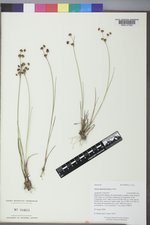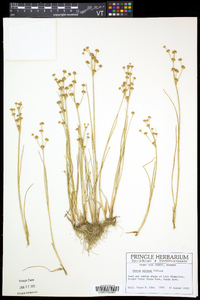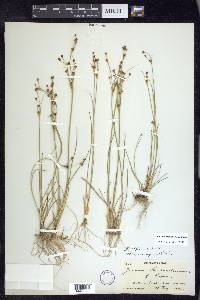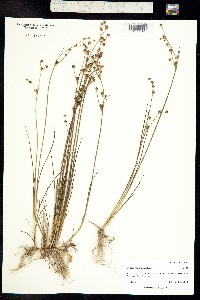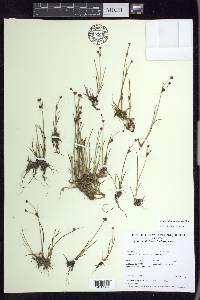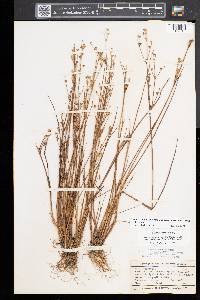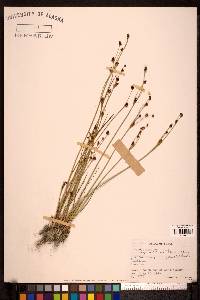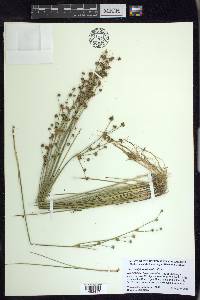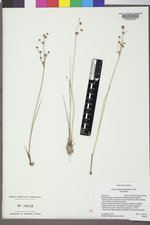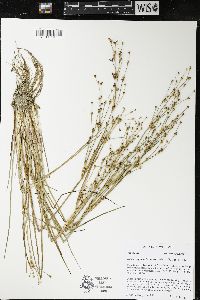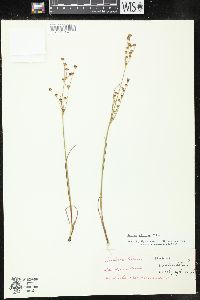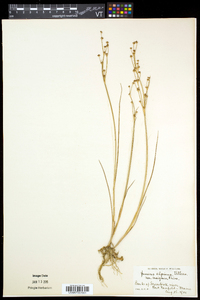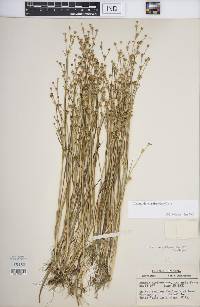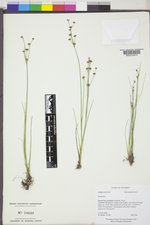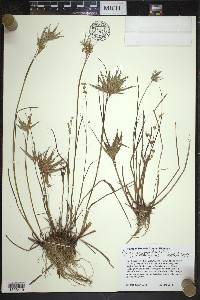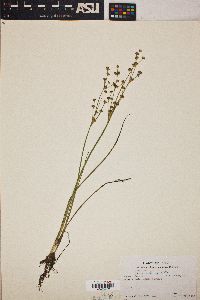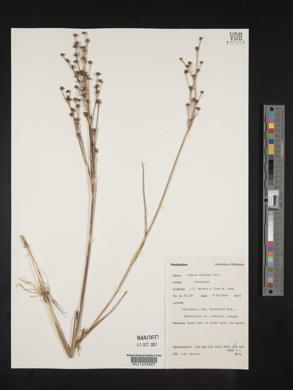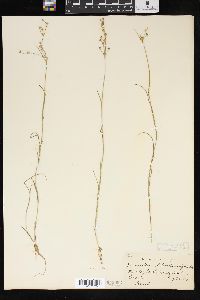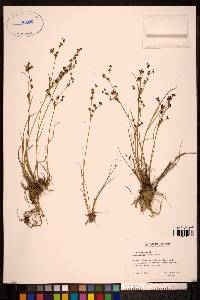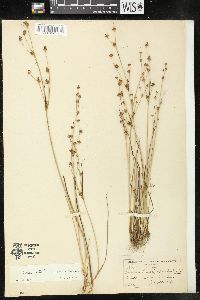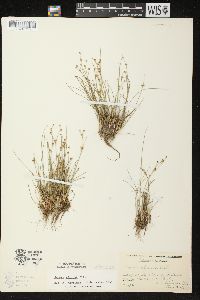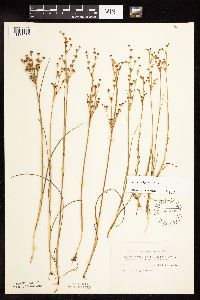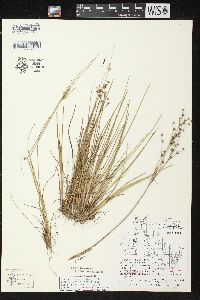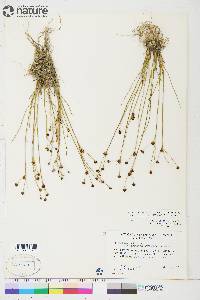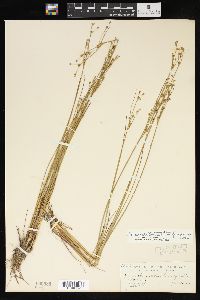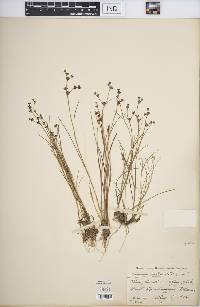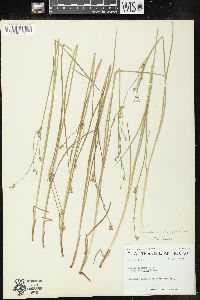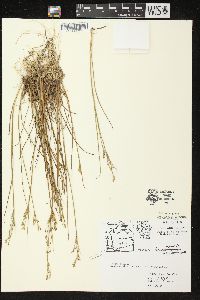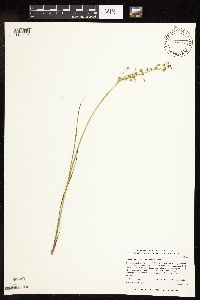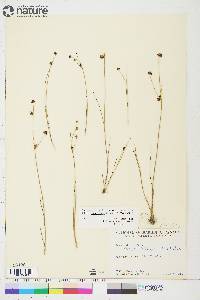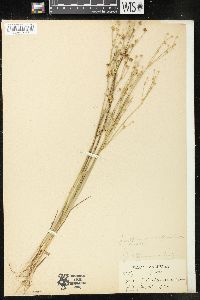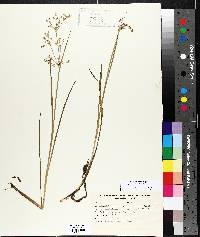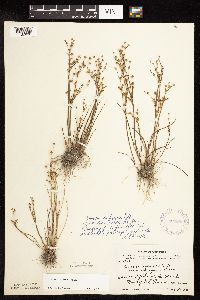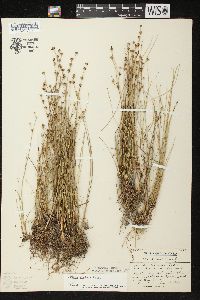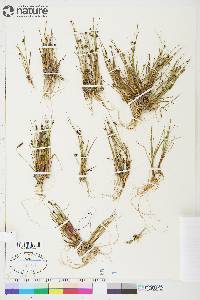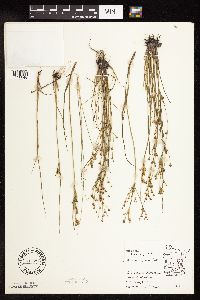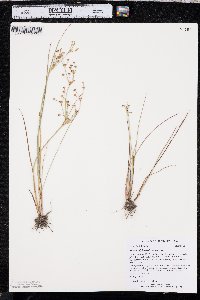
|
|
|
|
Family: Juncaceae
Northern Green Rush
[Juncus alpestris Hartm., moreJuncus alpinoarticulatus subsp. alpestris (Hartm.) Hämet-Ahti, Juncus alpinus Vill., Juncus alpinus var. alpestris (Hartm.) Almq., Juncus alpinus var. uniceps Hartm.] |
Herbs, perennial, rhizomatous, 0.5--5 dm. Rhizomes 2--4 mm diam., not swollen. Culms erect, terete, 1--3 mm diam., smooth. Cataphylls 0--1, straw-colored or maroon, apex acute. Leaves: basal 0--2, cauline 1--2(--5); auricles 0.5--1.2 mm, apex rounded, scarious; blade green to straw-colored, terete, 1.5--12 cm x 0.5--1.1 mm. Inflorescences terminal panicles of 5--25 heads, 3--11 cm, branches erect to ascending; primary bract erect; heads 2--10-flowered, obpyramidal, usually with some flowers short- pedicellateled, 2--6 mm in diam. Flowers: tepals greenish to straw-colored, lanceolate to oblong; outer tepals 1.8--3 mm, apex obtuse, mucronate; inner tepals 1.6--2.7 mm, apex obtuse; stamens 6, anthers 1/2 filament length. Capsules equaling perianth to usually exserted, chestnut brown to straw-colored, imperfectly 3-locular, oblong to oblong-ovoid, 2.3--3.5 mm, apex obtuse, valves separating at dehiscence. Seeds oblong to ovoid, 0.5--0.7 mm, not tailed. 2n = 40. Fruiting mid summer--fall. Wet meadows, sandy and gravelly, often calcareous shores, fens, and clayey pools over rock; 0--2600 m; Greenland; ; Alta., B.C., Man., N.B., Nfld. and Labr., N.S., N.W.T., Ont., P.E.I., Que., Sask., Yukon; Alaska, Colo., Idaho, Ill., Ind., Iowa, Maine, Mich., Minn., Mo., Mont., Nebr., N.Y., N.Dak., Ohio, Pa., S.Dak., Utah, Vt., Wash., Wis.; Eurasia. Several attempts have been made to separate subspecies or varieties of this widespread and variable species. In one study, five varieties were recognized, with four in North America ( B. Lindquist 1932) . In another, at least six subspecies were recognized with two in North America (L. Hämet-Ahti 1986). The variation we .have encountered does not fit nicely into the subspecies Hämet-Ahti has recognized, and until a full account of the variation throughout the range of the species is presented, we are not recognizing subspecific or varietal divisions of this species. Recent evidence suggests that this species may be one of the parents of the tetraploid Juncus articulatus. Juncus alpinus hybridizes with J. brevicaudatus (= J. ´ xgracilescens J. Hermann), J. articulatus (= J. ´ xalpiniformis Fernald), J. nodosus (= J. ´ xnodosiformis Fernald), and J. torreyi (= JuncusJ. ×stuckeyi Reinking).
Perennial grasslike forb 5 - 50 cm tall Leaves: none to two basal and one to four alternate on stem, green to straw-colored, 1.5 - 12 cm long, 0.5 - 1.1 mm diameter, linear, grasslike, round in cross section, and with distinct crosswise partitions inside (septate). The leaves also have a papery, basal, 0.5 - 1.2 mm long, round-tipped, ear-like appendage (auricle) at the top of the leaf sheath. Inflorescence: a terminal, elongate (3 - 11 cm long), narrow, erect to ascending-branched structure with branches ending in five to twenty-five, inversely pyramidal, 2 - 6 mm diameter flower clusters. Each flower cluster is a compact head of two to ten, tiny, radially symmetric flowers, of which some are usually short-stalked. Stamens: six, with anthers about half the length of the filaments. Pistil: with one superior ovary, and three stigmas. Fruit: somewhat three-chambered, chestnut-brown to straw-colored, equal or usually taller than tepals (2.3 - 3.5 mm), oblong to inversely egg-shaped, fairly round-tipped capsules which open down the sides. Stems: erect, smooth, round in cross section, 1 - 3 mm diameter, and arising from 2 - 4 mm diameter rhizomes lacking swollen nodes. Seeds: many, clear yellow-brown, 0.5 - 0.7 mm long, oblong to inversely egg-shaped with short-pointed or abruptly narrowed tips, but without distinct narrowed tails at the ends. Tepals: six in two whorls of three, greenish to straw-colored, lance-shaped to oblong. The three outer tepals are longer (1.8 - 3 mm) and are more blunt with a suddenly pointed tip, while the three inner tepals are only 1.6 - 2.7 mm long and have a blunt or rounded tip Similar species: Juncus alpinoarticulatus is most similar to J. articulatus, except in that species the inner three tepals have long, pointed tips, and the inflorescence is looser and more spreading in appearance. The hybrid between these two species, J. x alpiniformis, is also incredibly similar, but differs by having the inner three tepals longer than or equal to the outer three, and the capsules are gradually long-pointed at the tips. Flowering: June to September Habitat and ecology: Occasional, but most common in the eastern part of the Chicago Region in particular habitats such as moist, calcareous pond shores, pannes, calcareous marshy ground, and even some disturbed moist areas. Occurence in the Chicago region: native Notes: This species has also commonly been known as Juncus alpinus in our area. It hybridizes with several other species in the same subgenus, including J. brevicaudatus (to produce J. x gracilescens), J. articulatus (to produce J. x alpiniformis), J. nodosus (to produce J. x nodosiformis), and J. torreyi (to produce J. x stuckeyi). Etymology: Juncus is the classical name for Rush. Alpinoarticulatus is a combination of alpinus meaning alpine, and articulatus, meaning articulate or jointed. Author: The Field Museum Much like no. 38 [Juncus articulatus L.], avg a little smaller, mostly 0.5-3 dm; infl slender, 5-15 cm, less than half as wide, its branches ±closely ascending or erect; tep mostly 1.5-2.5 mm, the sep obtuse or rounded but sometimes minutely apiculate, the pet a little shorter, generally broadly rounded at the tip; fr obtuse or rounded to the stylar apiculation; 2n=40, 80. Wet meadows and sandy or gravelly shores; circumboreal, s. in our range to Pa., Ind., and Mo. (J. alpinus) The name J. alpinoarticulatus ssp. americanus (Farw.) H宥t-Ahti has been proposed to cover most of the American plants, together with those from Kamchatka and easternmost Siberia, but the taxonomy and nomenclature are complex. The hybrid with no. 38 is J. ءlpiniformis Fernald; that with no. 30. is J. سtuckeyi M. Reinking. Gleason, Henry A. & Cronquist, Arthur J. 1991. Manual of vascular plants of northeastern United States and adjacent Canada. lxxv + 910 pp. ©The New York Botanical Garden. All rights reserved. Used by permission. From Flora of Indiana (1940) by Charles C. Deam A single Indiana collection (Bebb no. 663, Clarke Junction, Lake County, Aug. 14, 1901) is characteristic of this variety, although transitional forms between the preceding variety and var. fuscescens are occasional. Its habitats are the same as those of var. rariflorus. …… Indiana Coefficient of Conservatism: C = 6 Wetland Indicator Status: OBL |

